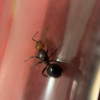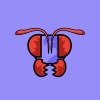Parasitic Slave-Raiding Formica
Formica sanguina group
Update 1
August 8, 2024
Ants_Dakota was camping in Custer State Park in the Black Hills of South Dakota. He came across the tail end of parasitic Formica flights, and caught several queens. He was kind enough to give me the queens he didn't want, so here we are. Shout out to AUD! Anyways, I have two species, both in the sanguinea group, which for now I'm going to call Formica cf. aserva and Formica cf. subintegra. We originally believed they were integra group, so we attempted polygyne, which resulted in the death of a couple queens. I have two of the cf. aserva queens and one of the cf. subintegra queens. AUD only wanted a shinier one that is also presumably in the sanguinea group, as he doesn't want to be completely loaded up with Formica colonies. His was one of the healthier queens. I introduced Formica fusca group host pupae to all of the queens, and they all began to groom them and transport them to the furthest reaches of their test tubes. The cf. subintegra queen seems the healthiest to me, and interestingly her host pupae are naked. Two workers have eclosed so far, with 6 more on the way. She has a total of 25 host brood including a couple larvae they are caring for. The cf. aserva queens have roughly 10 cocooned pupae each. I absolutely love parasitic Formica. While I think pallidefulva group queens are more beautiful per se, I can't get over the robust, aggressive look of sanguinea group Formica. These queens, unlike most others I've kept, seem to have personality. They're quick, nimble, aggressive, and have great eyesight, all of which contribute to their exaggerated-looking movements and behaviors. They seem to be looking at you - watching you - probably because they are. I'm super excited to keep these queens and am hoping they lay eggs before hibernation.
Formica cf. aserva Colony A



Formica cf. aserva Colony B
Formica cf. aserva Colony B 8/6/2024 (youtube.com)



Formica cf. subintegra


Edited by RushmoreAnts, April 19 2025 - 7:08 PM.












































![[CA] Looking for Formica (can buy/trade) - last post by bmb1bee](https://www.formiculture.com/uploads/profile/photo-thumb-6841.jpg?_r=1649821237)




